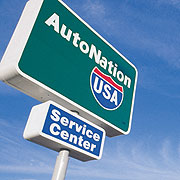European style gasoline prices

re suggested by the CEO of the nation's biggest automobile sales operation, Mike of AutoNation. See "Should You Pay $6 Per Gallon?," from Newsweek.
IMO, better to capture a goodly part of this revenue stream as tax, in order to be able to use the money to fund transit infrastructure, rather than let it go mostly to the oil companies as profits.
From the article:
But it might not take pricey technologies or outlandish gas prices to change our guzzling ways. Social stigma and inconvenience could do it, says Tom Kloza, energy analyst with the Oil Price Information Service in Wall, N.J. Kloza suggests that shopping malls and municipal parking lots start requiring the drivers of big rigs to park in the spaces farthest away. Or the popular electronic EZ Pass that commuters use to pay tolls without slowing down could be restricted to lighter cars while the heavyweights have to line up at the toll booth. All rental cars could be outfitted with GPS navigation so we don't waste gas getting lost. His most controversial idea: stop giving driver's licenses to 16-year-olds and we'll decrease the ever growing population of gasoline gulpers. "The laws allowing 16-year-olds to drive are based on an old agrarian economy where you needed to be licensed to drive a tractor or to drive to the grain elevator," says Kloza. "Why isn't there any dialogue on creating a national driving age of 17?"
Re the driving age to 17 years of age, in a suburban land use and development paradigm, where uses are separated by long distances, and to get to destinations for the most part you need a car, the issue is more significant and nuanced than Tom Kloza realizes. It's the land use paradigm as much as anything that shapes the "need" for suburban children to be able to drive as soon as possible.

Baby Blues, 10/8/2006
Labels: car culture, energy



0 Comments:
Post a Comment
<< Home